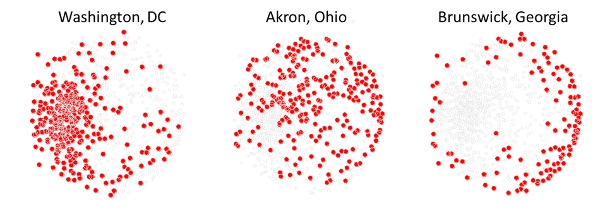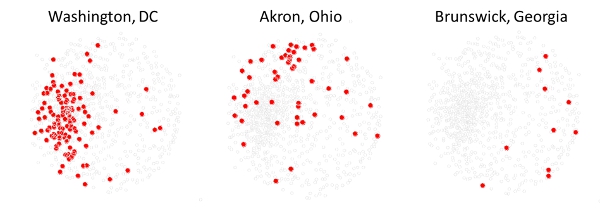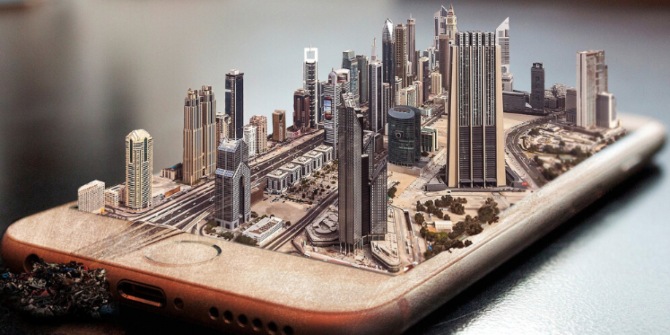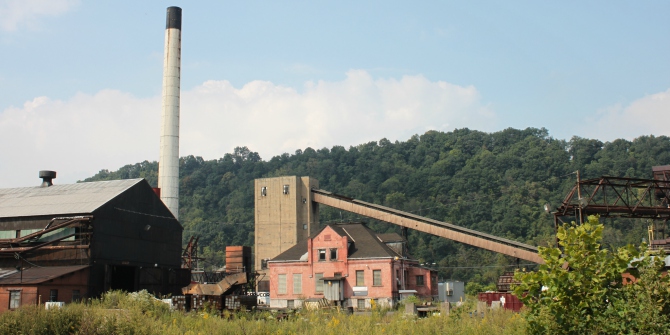 Cities across the US are now striving to emulate the successes of Silicon Valley and New York in transitioning to a creative economy. Shade Shutters cautions that despite the successes of some, it is often difficult for cities to make the transition to a creative economy. He argues that such cities face the challenge of moving through their current network of occupations to a more creative one, something that calls for a more comprehensive strategy than simply trying to attract greater numbers of knowledge workers.
Cities across the US are now striving to emulate the successes of Silicon Valley and New York in transitioning to a creative economy. Shade Shutters cautions that despite the successes of some, it is often difficult for cities to make the transition to a creative economy. He argues that such cities face the challenge of moving through their current network of occupations to a more creative one, something that calls for a more comprehensive strategy than simply trying to attract greater numbers of knowledge workers.
If you live in a city you’ve probably heard it from your local leaders – “why can’t our city be more like Silicon Valley in California? Like London? Like New York?” They’re talking about the creative economy and everyone seems to want to be a part of it. Cities around the world have crafted elaborate development plans to attract knowledge workers, lure high tech industries, and stimulate an innovation economy – all in a bid to increase average wages, foster economic prosperity, and enhance human well-being. Who wouldn’t want their city to be a global superstar?
But how easy is it for a city to transition to a creative economy? The answer turns out to be, not easy at all. In fact, in the decade preceding our recent study on the topic, only a small club of 19 US cities managed to maintain economies that were – according to the study’s novel metric – more creative than not. And the other 345 cities in the study? They may generate knowledge workers, but face a persistent tendency for those workers to move to existing hubs of innovation and high tech industry. As the musical group, The Andrews Sisters, sang 70 years ago, “Them that has, gets.”
So why is it so difficult for a city to make this transition to a creative economy? To better understand the difficult road that cities face, it is important to examine the complex and hidden structure of a city’s labor force. The pool of worker skills, embodied in a city’s portfolio of labor occupations, form an intricate web of interdependencies. Moving a city towards a more aspirational state, such as a creative economy, means breaking and rebuilding parts of that hidden web of labor connections. And this, it turns out, can be a quite difficult task.
One way to visualize these hidden structures is to create a network of occupations – a network in which occupations are closer or further apart depending on how they interact. In fact, some occupations may interact negatively, meaning they tend to compete for workers in a given city so that usually only one of the two occupations is prevalent. In our network, these occupations would be far apart. Others interact so strongly that they are almost always found together (or absent together), such as with surgeons and anesthesiologists.
With this network map in hand, we can find the location of individual cities within that map. And we may ask questions that we do of normal maps – how far apart are two cities? Or more importantly for our discussion, how far is my city from the creative economy? Using such network tools give a convenient method of visualizing the long journey a city may have to a creative economy.
Consider the example of three quite different US cities – Washington, DC, Akron, Ohio, and Brunswick, Georgia. Figure 1 shows the “location” of each of these cities within a US-specific network of labor occupations. Each city occupies a unique set of nodes or occupations. A node is occupied by a city if that city specializes in that occupation (or in labor terms, the occupation has a location quotient greater than one in that occupation).
Figure 1 – Comparison of how the labor structures of three US cities are located within the full US labor interdependency network.

Already, our three sample cities are visually quite different. But highlight only creative occupations, as in Figure 2, and the difference becomes quite striking. It is no surprise then that Washington ranks 2nd among 364 cities on the study’s Creative Jobs Index, while Akron ranks 63rd and Brunswick ranks 285th.
Figure 2 – Only creative occupations present in each city are highlighted within the overall labor network.

Thus the task facing a city is how to “move” through this network from its current location to a more desirable location. Given that this is a network and not a Euclidian space that humans are used to thinking about, the task is daunting. But a network perspective enables decision makers to lay out an optimal path through the network – a path of priority targets for occupational growth. Having this path also that helps avoid growth targets that are likely to fail because they are so far away from a city’s current labor structure.
One important implication of my study is that a strategy of simply attracting more knowledge workers is insufficient. Those cities that enjoy a robust creative economy and high tech sector also have a high diversity of so-called non-creative occupations. In one sense, a symbiotic relationship exists between creative and non-creative workforces and the most creative economies have successfully grown and diversified these groups in tandem. The same can be said for many high-tech industries and non-technical industries – they are complementary. Indeed, how would a university function if its only employees were scientists? (Answer: It wouldn’t).
Those complementary occupations and industries turn out to be critical for maintaining a creative workforce and this has consequences for a city that focuses too much on knowledge workers. Beyond the more obvious expectations of increased wage disparity, having a labor structure that is, in some sense, out of balance can have unforeseen effects on a city’s social and economic fabric.
Consider the current state of San Francisco, a city almost synonymous with high tech and knowledge workers. A recent report highlights the growing divide between high-tech, high wage workers and other workers and the effects this gap is having on mass transportation, housing affordability, political satisfaction and, ultimately, citizen well-being. If workers in complementary occupations cannot afford to live in the market they help support and cannot justify a costly commute, their ability to play a supporting role in a creative economy may be diminished.
Overall, policy makers seeking a creative urban economy face a hard road. The difficulty is not only in effecting a desired transition, but also in how to maintain a balanced growth that preserves what progress they do make. Fortunately, data tools like the network map described here will continue to develop and address the needs of decision makers. One day, perhaps soon, the path forward for individual cities will be clearer and simpler.
Featured image credit: Justin Brown (Flickr, CC-BY-NC-SA-2.0)
Please read our comments policy before commenting.
Note: This article gives the views of the author, and not the position of USAPP – American Politics and Policy, nor the London School of Economics.
Shortened URL for this post: http://bit.ly/1lUgMQ7
_________________________________
 Shade Shutters – Arizona State University
Shade Shutters – Arizona State University
Shade Shutters is a research scientist with the Global Security Initiative at Arizona State University, in Tempe, Arizona, USA. His research interests include urban dynamics and economic development, intercity trade networks, metropolitan science, and an emerging applied field of “municipal intelligence”. Prior to earning a doctorate in theoretical ecology, he worked for several years in the field of international finance. His two most recent relevant publications are, How hard is it for urban economies to become “green”? (2015) in Environment & Planning B: Planning and Design and Quantifying urban economic resilience through labour force interdependence (Palgrave, 2015).







1 Comments